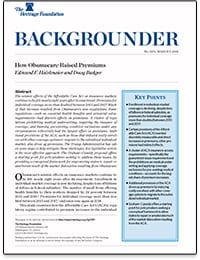The seismic effects of the Affordable Care Act on insurance markets continue to be felt nearly eight years after its enactment. Premiums for individual coverage more than doubled between 2013 and 2017. Much of that increase resulted from Obamacare’s new regulations. Some regulations—such as essential health benefits and actuarial value requirements—had discrete effects on premiums. A cluster of regu- lations prohibiting medical underwriting, requiring the issuance of coverage, and banning pre-existing condition exclusions under any circumstances collectively had the largest effect on premiums. Addi- tional provisions of the ACA, such as those that induced costly enroll- ees with other coverage options to migrate to the subsidized individual market, also drove up premiums. The Trump Administration has tak- en some steps to help mitigate these challenges, but legislative action is the most effective approach. The Graham–Cassidy proposal offers a starting point for policymakers seeking to address these issues, by providing a conceptual framework for empowering states to repair or ameliorate much of the market dislocation resulting from Obamacare.

